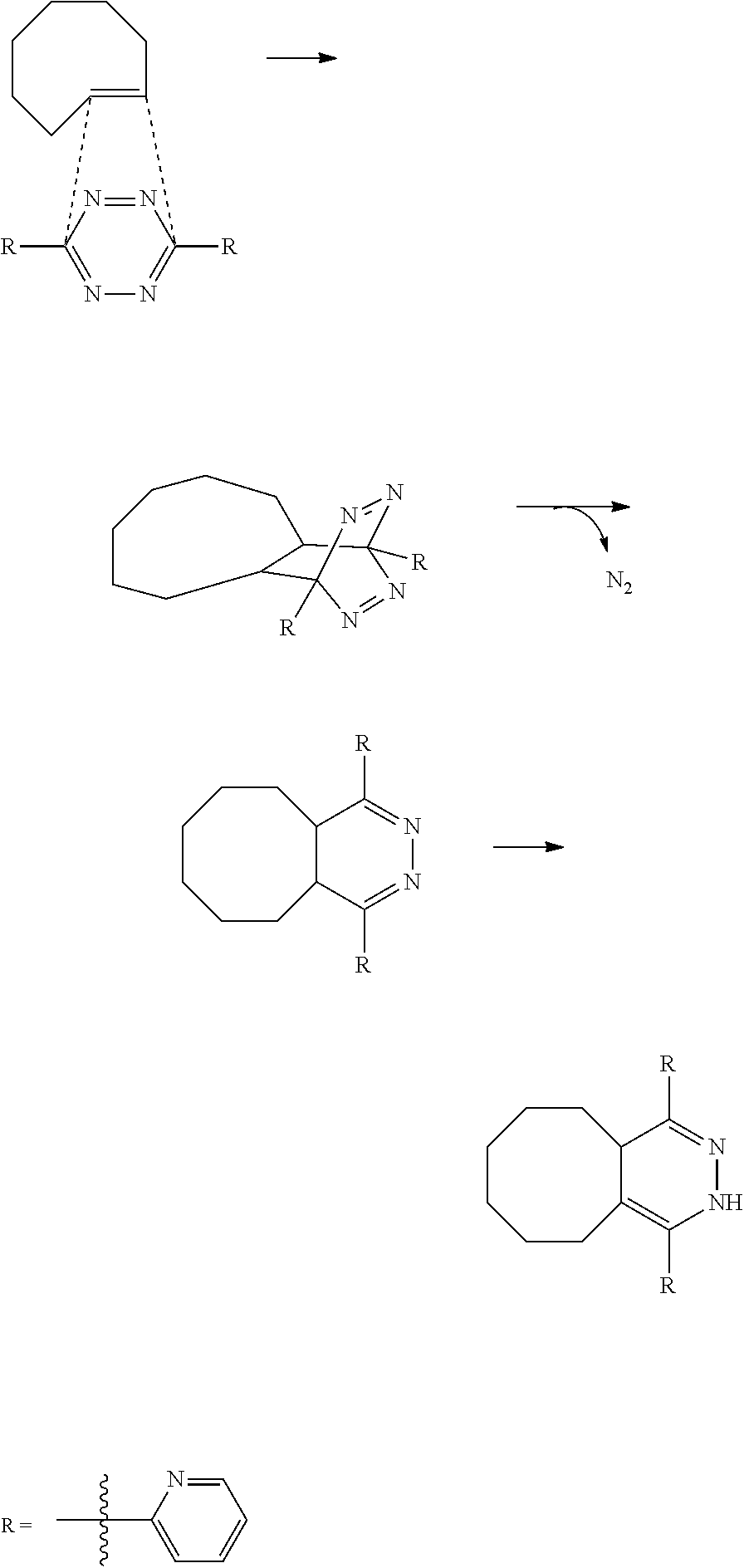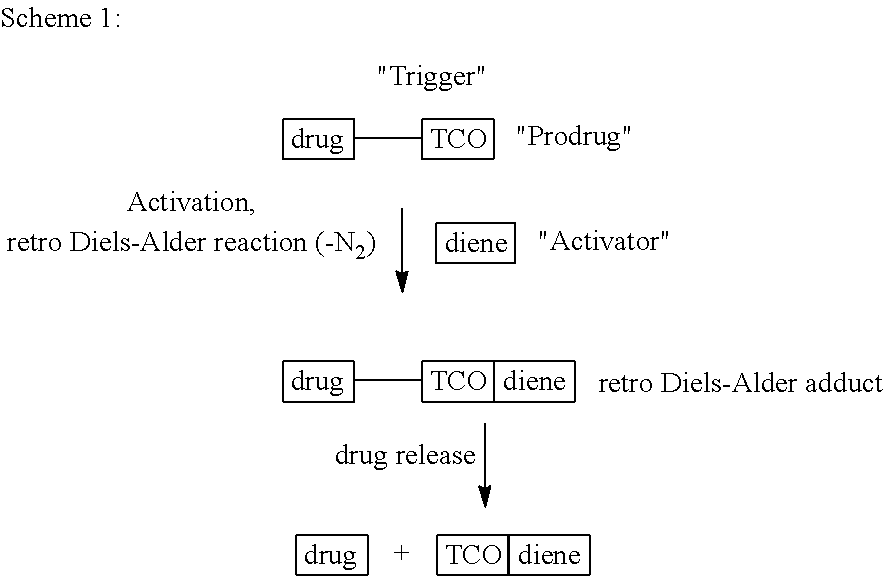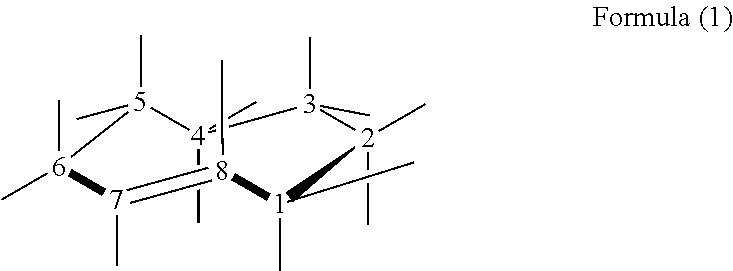Bio-orthogonal drug activation
a bio-orthogonal and drug technology, applied in the field of inactivated drugs, can solve the problems of inability to repeat administration, lack of suitable overexpressed enzymes, and limited success of strategy
- Summary
- Abstract
- Description
- Claims
- Application Information
AI Technical Summary
Benefits of technology
Problems solved by technology
Method used
Image
Examples
example 1
Synthesis of Tetrazine Activators
General Procedures
[0210]Apart from the tetrazines described in detail below, a series of other tetrazines have been prepared. Pinner-type reactions have been used, where the appropriate nitriles have been reacted with hydrazine to make the dihydro 1,2,4,5-tetrazine intermediates. Instead of nitriles, amidines have also been used as reactants, as is known in the art. The use of sulfur in this reaction is also known, as in some cases this aids the formation of the dihydro 1,2,4,5-tetrazine. Oxidation of this intermediate results in the tetrazine diene Activators. The below reactions describe some of the prepared tetrazines, and illustrate some of the possibilities (e.g. use of solvent, concentrations, temperature, equivalents of reactants, options for oxidation, etc.) to make and isolate tetrazines. Other methods known in the art may also be used to prepare tetrazines or other Activators.
Synthesis of 3,6-bis(2-pyridyl)-1,2,4,5-tetrazine (2)
[0211]
[0212]...
example 2
Synthesis of (E)-cyclooctene Model Prodrugs and Prodrugs
Synthesis of (E)-cyclooct-2-enol (31), (E)-cyclooct-2-en-1-yl benzylcarbamate (32), and (E)-cyclooct-2-en-1-yl (3,5-dimethylphenyl)carbamate (33)
[0261]
Synthesis of (E)-cyclooct-2-enol (31)
[0262]A solution of (Z)-cyclooct-2-enol 30 (2.36 g, 14.0 mmol) and methyl benzoate (1.8 mL, 1.94 g, 14.3 mmol, 1.0 eq) in diethyl ether / heptanes 1:2 (500 mL) was irradiated for 32 hr, while it was continuously lead through a column filled with silica / silver nitrate 10: 1 (41 g), silica (0.5 cm) and sand (0.5 cm). The column was placed in the dark during the irradiation. The column was eluted with dichloromethane (250 mL) to give unreacted starting material. The silica was stirred with dichloromethane / 12.5% aqueous ammonia 1:1 (3×100 mL). The combined organic layers were dried over sodium sulfate, filtered and evaporated in vacuo to give crude product 31 as a grey oil. The oil was purified by column chromatography (silica, eluens pentane / diethy...
example 3
Stability and Reactivity of Tetrazine Activators
Hydrolytic Stability Tests of Tetrazines
[0313]10 μL of a solution of the specific tetrazine in DMSO (25 mM) was diluted with PBS buffer (3 mL) (or a mixture of PBS and acetonitrile in case the aqueous solubility was too low). This solution was filtered and, the decrease of the absorption band at 525 nm was monitored using UV spectroscopy. The rate of hydrolysis and half-life time was determined from these data.
Reactivity of Tetrazines Towards trans-cyclooct-4-ene-1-ol (Axial Isomer)
[0314]A competition experiment was performed to determine the reactivity ratio of a specific tetrazine and 3-(5-acetamido-2-pyridyl)-6-(2-pyridyl)-1,2,4,5-tetrazine (5) (that was chosen as the reference tetrazine), in the inverse-electron demand Diels-Alder reaction with trans-cyclooct-4-ene-1-ol (“minor” isomer with OH in axial position, see: Whitham et al. J. Chem. Soc. (C), 1971, 883-896)).
[0315]To acetonitrile (0.100 mL) was added 5 μL of a solution of t...
PUM
| Property | Measurement | Unit |
|---|---|---|
| temperature | aaaaa | aaaaa |
| flow rate | aaaaa | aaaaa |
| volume | aaaaa | aaaaa |
Abstract
Description
Claims
Application Information
 Login to View More
Login to View More - R&D
- Intellectual Property
- Life Sciences
- Materials
- Tech Scout
- Unparalleled Data Quality
- Higher Quality Content
- 60% Fewer Hallucinations
Browse by: Latest US Patents, China's latest patents, Technical Efficacy Thesaurus, Application Domain, Technology Topic, Popular Technical Reports.
© 2025 PatSnap. All rights reserved.Legal|Privacy policy|Modern Slavery Act Transparency Statement|Sitemap|About US| Contact US: help@patsnap.com



